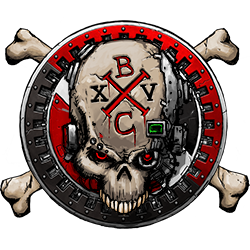Search the Community
Showing results for tags 'Agrax Earthshade'.
-
I thought it would be reasonable to dedicate a thread to Agrax Earthshade (and other washes). Agrax Earthshade is used by Duncan in almost... everything and some people have taken to calling it Liquid Talent due to the great results you can get from it. To start: what is a wash. A wash or as GW markets them, a shade is a paint that is very fluid (usually the consistency of water or milk) that is translucent and has relatively little pigment. These characteristics are what give washes their role. When washes are applied, they tend to tint the model in the colour of the wash while allowing the base colour to shine through. This is most noticeable when you apply them to a light colour. Applying a green wash to a white model will leave you with a light green model due to the translucency of the paint allowing white to shine through. An example of this is where Cassandora Yellow is painting over a mostly white model to create a consistent, yellow model. This is one way to paint yellow armour for Imperial Fists: https://youtu.be/biqPX_uQ6m0?t=267 The high fluidity of washes is another key characteristics. GW calls them shades because when a wash is applied to a model, the liquid paint will tend to pool/flow into recesses. Since most of the pigment settles in the recesses, the recesses will have stronger colour. This allows you to easily add shadows to a model (remembering that a shadow is a dark colour in a recess. The opposite is a highlight, which is a light colour on a raised edge). An example of using a very thin, wash-like paint to add darkness to recesses is here, using Tamiya Panel Line Accent Colour: https://youtu.be/mDeuXW4hScA?t=80 The main uses of washes use their thin consistency and translucency to create shading effects in recesses, panel lines or curves. Another is to tint areas of a model in a colour while allowing the underlying colour to shine through, such as in the case of tinted flesh. Agrax Earthshade Agrax Earthshade is produced by Games Workshop and has achieved a meme status among some painters for its usefulness. Characteristically, Agrax Earthshade is simply a medium brown wash paint. It is in fact more expensive than other options like mixing your own washes or those from other companies, but due to the popularity of Duncan Rhodes' painting videos and of the hobby in general, this paint has become popular. Agrax Earthshade can be substituted with a brown paint of very thin consistency for any of its applications, although you might have a hard time getting a perfect colour match. Here are some of the uses for Agrax Earthshade. Feel free to add more: 1. Paint dirty, winter camouflage like this using white and Agrax Earthshade. First prime the model white or prime and paint it entirely white. Then cover the entire model in Agrax Earthshade. This will give it a ruddy brown tint. Then Drybrush white very heavily across the entire model to return it to white. This leaves Agrax Earthshade in the recesses, where they remain brown and add shadows while the rest of the model is white. This method avoids the traditional hassle of washing white models where you want to avoid getting brown paint where you don't want it. In this case, you get brown paint everywhere and then just build the white back up with drybrushing. 2. Use Agrax Earthshade in an airbrush to tint a model a darker shade. If you have a colour and want to tint it to a darker colour, airbrushing a wash over it can make it dramatically darker. Airbrushing also gives you control over how much tint you use. This can be used to create rather unique colours and gradients. This model uses Tamiya Flat Red as a base, but Tamiya Flat Red is very bright. Progressive layers of Agrax Earthshade airbrushed onto the model darken the model. 3. Brown, oily metal. One of the classic ways to get brown, oily metal with a bit of depth is to start with a grey metallic colour like Leadbelcher and simply cover it in Agrax Earthshade. The shade flows into recesses adding depth and tints the model brown, as seen here. 4. Washing down bright foliage. If you have bought or painted brightly coloured flora and foliage (like from a pet store) and want to darken it, a simple way is to cover it in Agrax Earthshade. The brown hue is common to soil, dirt and dust in nature and will tint the terrain a darker colour. 5. Gehenna's Gold + Agrax Earthshade = easy, rich gold. Seen here on the banner. Methods using washes in general 1. Speedpainting surfaces. Using washes is a foundation of speedpainting. Washes cover models easily while simultaneously applying colour and shading them. Their translucency lets them blend naturally into other colours so mistakes are harder to see and their translucency is also easy to paint over using other colours to cover mistakes. Entire armies can be painted quickly by mixing washes over a light grey/white surface with normal painting techniques. Duncan Rhodes paints a poxwalker very quickly using green wash over white to make pallid green flesh, then only picking out basic details like trousers, then washing with Agrax Earthshade to tie the model together. 2. Painting yellow or other light-coloured armies. Light colours have a bad reputation because it is easy to see mistakes on a bright surface. Traditionally, painting armies with light colours is time-consuming due to the need for precise brushwork, precise thinning and many layers. One easy way to paint colours like Imperial Fists yellow is to start with a white base and simply wash the model using a wash to tint it that colour. Take care to make sure the wash does not pool on flat surfaces. An example involving painting Imperial Fists yellow is here: https://youtu.be/biqPX_uQ6m0?t=267 3. Simultaneously painting and shading flesh. Starting with a grey base and simply washing the area in a flesh-tinted wash immediately tints it in your colour of choice while also shading the recesses of musculature. Examples here and here using Athonian Camoshade and Reaper Flesh Shade 4. Rapid shading and model protection using Army Painter Quick Shade. Army Painter produces a line of products called Quick Shade, which are essentially thinned wood varnishes. Rather than painting a model with it, you dip the entire model in like some kind of baby Achilles and let the excess drip off. When it dries, your entire model is shaded and tinted and the paint is formulated to leave a protective coat over the model as well. Example here. 5. Multi-colour heat burn effects. Washes of different tones applied to a metallic surface can be used to easily create a gradient reminiscent of burns on a metal surface, such as flamethrower or jet engine nozzles. Duncan Rhodes shows the technique using 3 washes here. That's all I have. Add more entertaining uses for washes in the comments!


